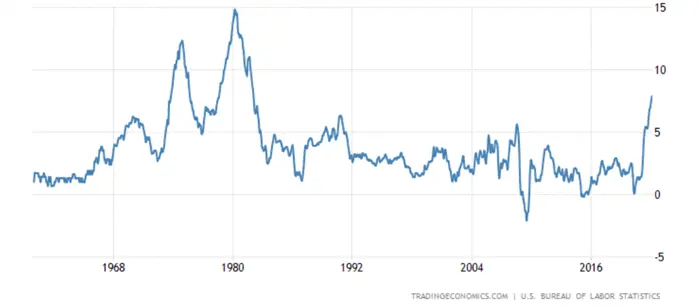The last year has seen the Consumer Price Index (CPI) in the US surge higher, but it has only been in the last three months that the Federal Reserve has indicated it will lift the overnight rate meaningfully. As the warnings of higher rates have increased, the old debate about whether increased interest rates cause recessions has enlivened. As the graph below from tradingeconomics.com shows, the US CPI is at its highest level for 40 years with the pace of the increase particularly worrisome.

Keynesian economists tend to focus more on the short term impacts and thus generally believe that central banks raising interest rates too far causes recessions. Austrian economists tend to take a longer term view and see the excesses that preceded the interest rate increases as the cause of recessions. Whilst this can initially seem pedantic and technical, the conclusion reached has a significant impact on how central banks and governments respond to cycles; which can either exacerbate or flatten them.
The last 25 years has seen the Keynesian way of thinking dominate government and central bank policy making. Central bank (electronic) money printing, ultra low interest rates and substantial government deficits have all been used in increasing measure to try to eliminate recessions. At first, there was a limited impact on inflation which encouraged governments and central banks to stimulate further and allowed proponents of modern monetary theory (MMT) to claim there are no material constraints on governments printing and spending. It’s funny how MMT proponents have been far less vocal in the last year as US inflation has soared.
Those who undertake a cursory review of developed economies over the last 200 years will see that recessions are a regular part of economic life. Many introductory economics textbooks will talk of a 5-10 year business cycle with most of this being a gradual expansion phase followed by a short contraction phase. Participants in financial markets recognise this cycle as well, with the youngest workers often embracing the new developments (think cryptocurrencies and NFTs today, sub-prime loans in 2004-2007, technology stocks in 1998-2000) whilst old heads stay away and for a while look like fools missing out on the party. Recessions are the most effective way of clearing out the trash, reminding investors to focus on activities that make long term profits.
By seeking to eliminate or at least significantly reduce the severity of the recessions, governments and central banks have merely deferred the pain. Several cycles worth of malinvestment and government wastefulness have now accumulated, which together create the risk of a far more severe contraction. Excessive stimulus has given us low productivity and high inflation, with stagflation having the potential to linger for a decade or more (think Japan and Greece) if the existing approach remains.
The alternative approach is to take the medicine Paul Volcker style and allow the economy to be cleansed of excesses and exuberance. Central banks should allow quantitative easing to roll-off without replacement and raise overnight interest rates to levels that allow citizens to earn a positive return after tax and inflation. (This implies that both inflation and tax levels need to reduce.) Significantly reduced government spending, taxation reform and productivity reform are the proven methods to generate long term growth.
